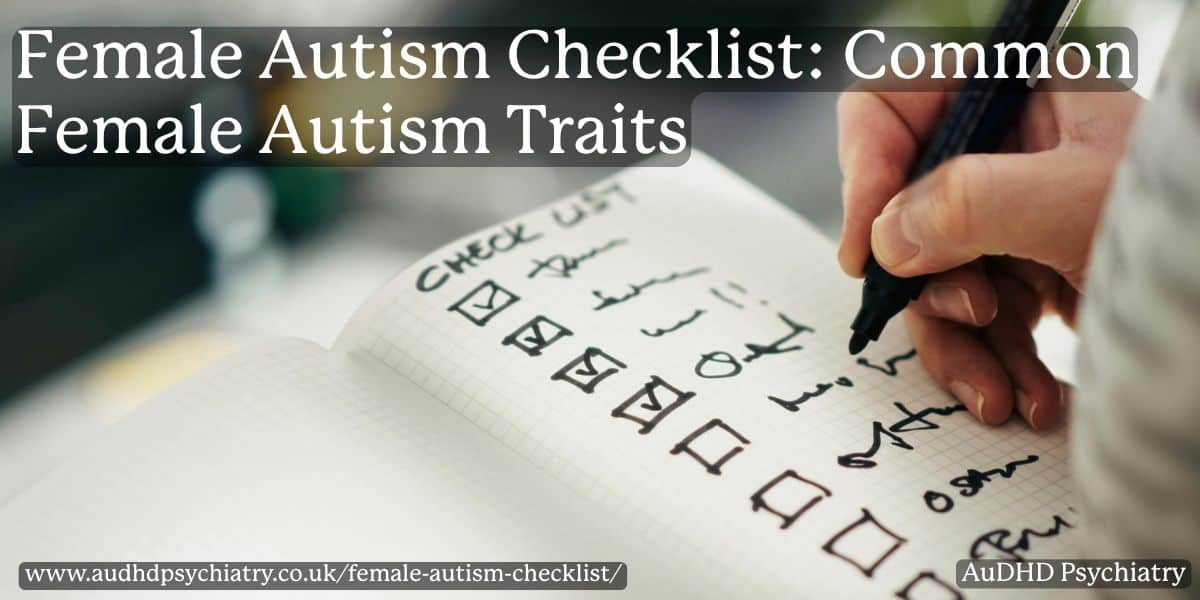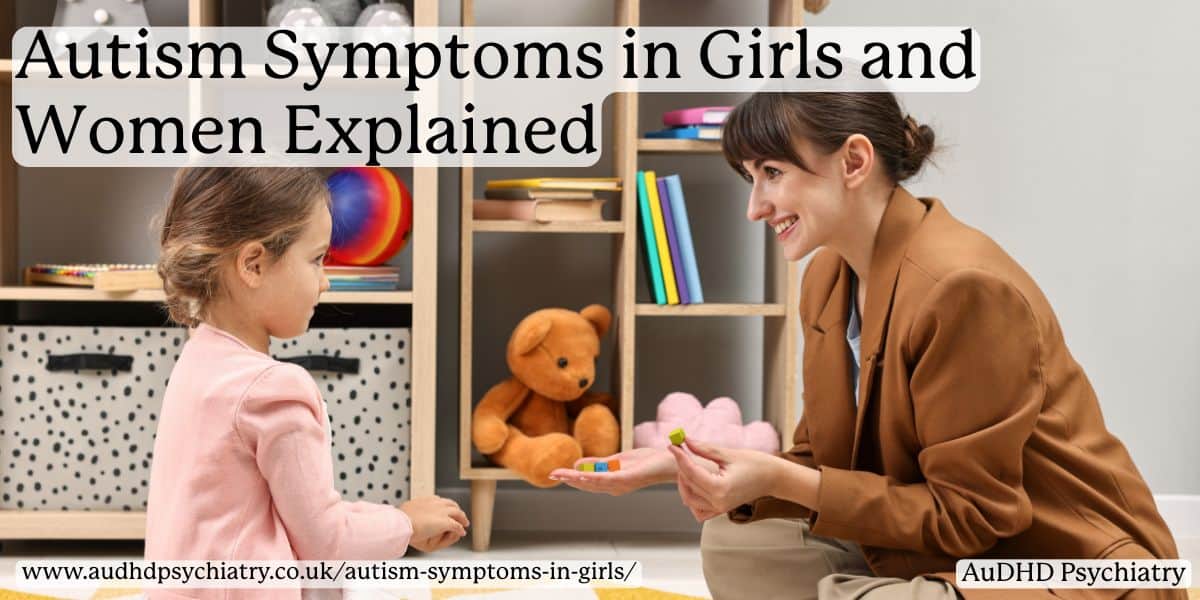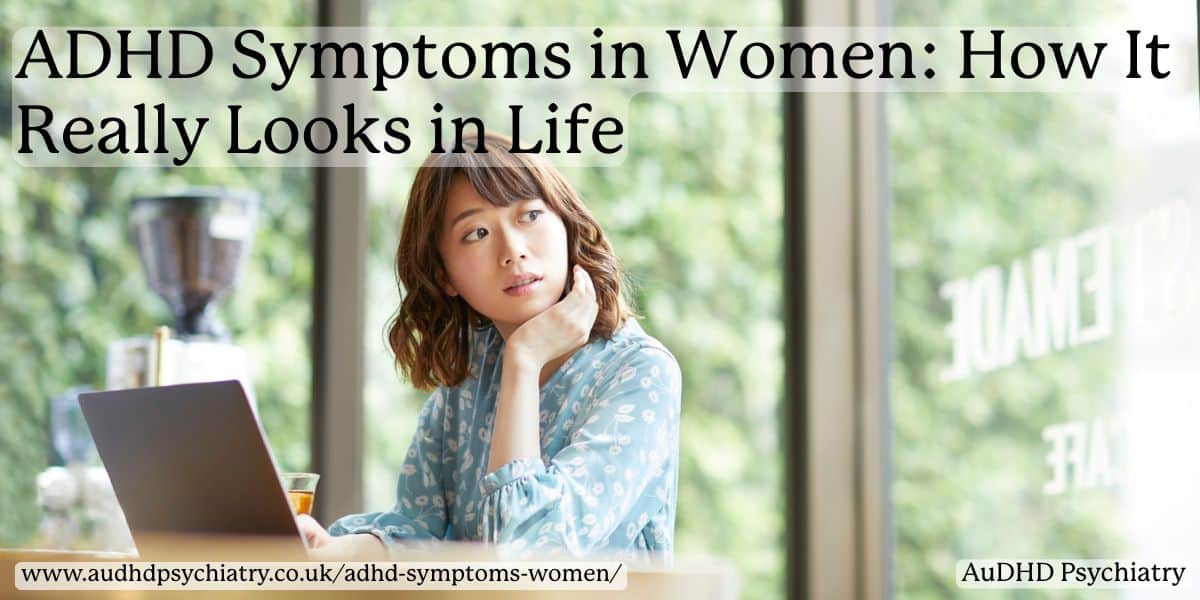
Do you often feel mentally scattered no matter how hard you try to stay organised? For many women, that constant distraction, emotional overload, and fatigue aren’t signs of failure; they’re signs of ADH.. Unlike the hyperactive, disruptive image often portrayed in boys, female ADHD tends to appear as quiet inattention, perfectionism, or burnout from masking symptoms to meet expectations.
This difference means ADHD in women often goes undiagnosed or mistaken for anxiety or depression, delaying access to the right support. Understanding how ADHD presents in women is the first step toward clarity and treatment.
At AuDHD Psychiatry, our clinicians are not only qualified to hold ADHD assessments and treatment; they also specialise in recognising the subtle ways ADHD affects women across different life stages, from teenage years to motherhood and beyond. Let’s explore how these symptoms really look in everyday life and why awareness matters.
How Do ADHD Symptoms Represent in Women?
Attention deficit hyperactivity disorder (ADHD) is a neurodevelopmental disorder that affects attention, focus, and self-regulation. Yet for many women, it doesn’t look like the stereotypical image of a restless, disruptive child. Instead, ADHD in women often appears subtle. It can be overlooked for years or mistaken for personality quirks or emotional issues.
Inattentive and Impulsive Traits
Many women with ADHD show symptoms of inattentive ADHD, which involves:
- Losing focus during conversations or reading
- Struggling to follow through on plans or deadlines
- Frequently misplacing items or forgetting appointments
Some may also experience impulsive behaviour, such as speaking out of turn or making quick decisions under stress. However, these impulses often manifest internally as racing thoughts or emotional reactivity rather than outward hyperactivity.
Hormones and the Female ADHD Experience
Fluctuating hormonal changes play a major role in how ADHD in females presents. Oestrogen and progesterone shifts during puberty, menstruation, pregnancy, and menopause can intensify ADHD symptoms in women, making focus, mood, and motivation harder to manage.
Many report worsening symptoms before their period or after childbirth, when hormone levels drop sharply. These cyclical changes are key to understanding why female ADHD is underdiagnosed and under-researched [2].
Why It’s Often Missed
Because girls are typically socialised to be compliant and organised, they learn to hide their struggles—a behaviour known as “masking.” This effort to appear in control can lead to exhaustion, low self-esteem, and a delay in diagnosis. Recognising how ADHD in women’s symptoms differ from men’s experiences is vital for accurate, compassionate assessment and care.
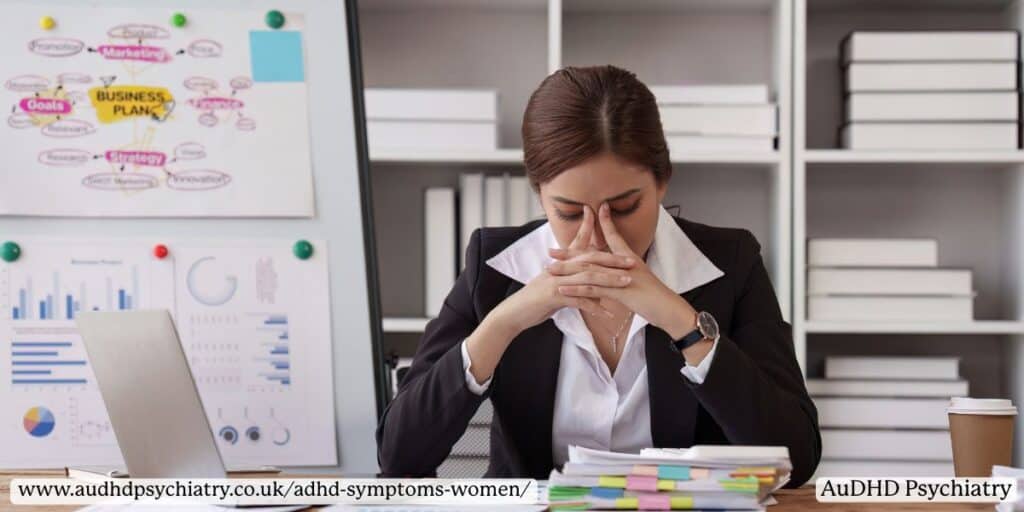
Common ADHD Symptoms in Women
ADHD in adult women affects nearly every aspect of life, from work and relationships to emotional well-being. Symptoms can range from subtle disorganisation to overwhelming exhaustion, often compounded by the pressure to keep everything together.
Emotional and Cognitive Symptoms
Many women experience:
- Difficulty with executive function, including planning and time management
- Frequent mood swings and emotional sensitivity
- Chronic stress from balancing family, work, and social expectations
Internal restlessness often replaces outward hyperactivity. Rather than fidgeting, women may feel mentally overstimulated, always “on” but rarely at ease. These constant mental demands can lead to fatigue and feelings of underachievement, even when they’re putting in tremendous effort.
Behavioural and Physical Symptoms
In daily life, symptoms of ADHD in women may include:
- Persistent forgetfulness and missed deadlines
- Disorganisation and cluttered spaces
- Inconsistent energy; alternating between hyperfocus and burnout
- Tendency to people-please to hide struggles
Many also notice irregular sleep, physical tension, or low motivation after emotional crashes. Over time, this can affect daily functioning, relationships, and self-image.
Awareness of these patterns allows women to recognise their experiences as valid, not as failures, but as signs of ADHD in women that deserve attention and support. If these traits sound familiar, consider seeking a professional ADHD assessment. Understanding your unique symptom profile is the first step toward personalised treatment, therapy, and long-term wellbeing.
Why ADHD Often Goes Undiagnosed in Women
Many women grow up believing their struggles with focus, time management, and exhaustion are personal shortcomings rather than symptoms of ADHD. This misunderstanding often leads to undiagnosed ADHD, especially when symptoms are masked or misinterpreted by healthcare professionals.
Gender Stereotypes and Masking
Traditional ADHD research focused primarily on young boys, meaning diagnostic criteria were shaped around hyperactivity and outwardly disruptive behaviour [1]. Because many women with ADHD present with inattentive symptoms, such as daydreaming or disorganisation, they often go unnoticed.
To cope, women frequently develop masking strategies, including:
- Overcompensating with perfectionism
- Hiding disorganisation through excessive planning
- Internalising frustration or guilt
While these coping mechanisms can create an illusion of control, they come at a cost. Constant self-monitoring can lead to chronic stress, fatigue, and feelings of inadequacy.
Misdiagnosis and Bias in Healthcare
When ADHD in women is finally discussed, it’s often mistaken for anxiety disorders, depression, or personality disorders. Many mental health professionals still associate ADHD primarily with hyperactive boys, overlooking the emotional and cognitive difficulties that women report.
Lack of awareness and training among clinicians contributes to this diagnostic gap. Without an understanding of gender differences, women are more likely to be treated for secondary issues such as low mood or poor sleep, instead of the underlying neurodevelopmental disorder.
The Path to Accurate Diagnosis
Acknowledging these biases is vital for improving access to care. Women who suspect ADHD should seek specialists experienced in diagnosing ADHD in women, such as those at AuDHD Psychiatry. Booking an accurate assessment allows for tailored treatment, emotional relief, and practical support—helping women reclaim confidence in their daily lives.
ADHD in Girls and Across Different Life Stages
ADHD doesn’t suddenly appear in adulthood. It often starts in childhood but goes unnoticed due to subtler behaviour and social expectations. Recognising how symptoms evolve from girlhood to later life can help families and clinicians identify female ADHD earlier.
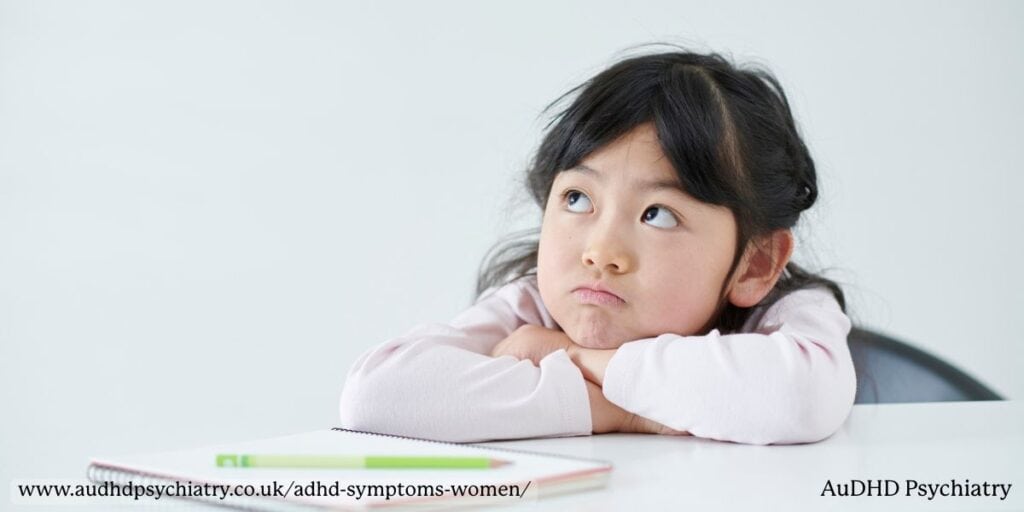
Early Signs in Girls
ADHD in girls may manifest as:
- Quiet inattentiveness or daydreaming
- Forgetfulness and trouble following multi-step instructions
- Emotional outbursts or sensitivity to criticism
- Struggles with time management or school routines
Because these traits don’t always disrupt others, teachers and parents might interpret them as immaturity, shyness, or laziness. Many girls learn to overcompensate, pushing themselves to meet expectations, often leading to low self-esteem and exhaustion.
Changing Symptoms Through Adulthood
ADHD in adult females can shift as life responsibilities grow. Many women notice challenges with organisation, emotional regulation, and multitasking, especially during major transitions like university, parenthood, or career progression. Hormonal fluctuations during pregnancy, postpartum recovery, and menopause can also influence symptom severity.
These cycles of focus and fatigue often make women question their abilities or feel like they’re constantly “failing to keep up.” Recognising these hormonal and situational influences can help reframe those experiences as symptoms, not character flaws.
Why Life Stage Awareness Matters
Understanding ADHD across the lifespan enables timely intervention and more compassionate self-awareness. Early diagnosis in young girls can prevent years of frustration, while adult assessments offer tools to navigate motherhood, relationships, and work more confidently.
Coexisting Conditions and Misdiagnosis in Women
Many women with ADHD spend years navigating other mental health diagnoses before discovering their symptoms stem from ADHD. This is partly because ADHD often overlaps with other conditions—a reality that can obscure the full picture of someone’s mental health.
Common Coexisting Conditions in ADHD Women
It’s not uncommon for ADHD in women to coexist with:
- Anxiety disorders – constant worry or racing thoughts linked to chronic overwhelm
- Depression – low mood from repeated failures to meet expectations or stay organised
- Sleep disorders – irregular sleep patterns caused by restlessness or hyperfocus
- Premenstrual dysphoric disorder (PMDD) – hormonal fluctuations that intensify ADHD symptoms
- Substance use – a coping mechanism for emotional regulation or fatigue
These overlapping traits can make daily life more difficult and mask the root cause of distress. For instance, a woman treated for anxiety may find only partial relief until her ADHD is recognised and managed.
Overlap With Autism and Emotional Sensitivity
Research shows significant overlap between ADHD and autism in women, particularly in areas of sensory sensitivity, social exhaustion, and difficulty maintaining routines. Many women are highly empathetic yet easily overstimulated, which is a combination that can make social interaction tiring and unpredictable.
The Emotional Cost of Misdiagnosis
Misdiagnosis delays effective treatment and can erode confidence over time. Women may internalise their struggles as personal failings rather than neurological differences. By seeking a comprehensive ADHD and neurodivergence assessment and treatment (if diagnosed), individuals can finally understand the true source of their challenges and access support designed for their needs.

ADHD Symptoms Women vs Men
Although ADHD affects both genders, its expression can differ widely. Understanding these distinctions helps explain why ADHD in women often goes unnoticed for so long and why tailored care is essential.
How Does ADHD Present in Women?
Men are more likely to display outward hyperactive symptoms, such as fidgeting or impulsivity. By contrast, women with ADHD typically experience inattentive symptoms like zoning out, misplacing items, or struggling to prioritise. This subtle presentation leads to underdiagnosis and misunderstanding.
Women also tend to internalise their symptoms, creating a cycle of self-blame and emotional distress. Many adopt coping mechanisms like:
- Overworking to hide disorganisation
- Avoiding group settings to mask distractibility
- Relying on perfectionism for control
These behaviours can help in the short term, but often lead to burnout and mental fatigue.
High-Functioning ADHD and Emotional Load
Some women present with what’s called high-functioning ADHD, appearing organised on the surface while battling constant inner chaos. They may achieve success in academics or careers yet feel perpetually on the verge of collapse. Hormonal shifts can intensify this imbalance, worsening focus and mood during certain phases of the menstrual cycle.
The Role of Gender Stereotypes
Gender expectations play a major role in delayed diagnosis. As we’ve mentioned before, society may expect women to be emotionally balanced and reliable, qualities that conflict with ADHD traits like distractibility or impulsivity. As a result, ADHD women are judged more harshly, even by themselves, and hesitate to seek help.
Raising awareness of these gender differences is crucial for improving diagnostic accuracy and ensuring women receive treatment that addresses both biological and social factors influencing ADHD in females.
Getting Diagnosed: ADHD Tests and Assessments for Women
For many women with ADHD, reaching a diagnosis is a turning point—the moment years of confusion begin to make sense. Understanding what to expect during an assessment can make the process less overwhelming and more empowering.
What to Expect in an ADHD Assessment
An ADHD diagnosis involves a comprehensive evaluation rather than a single test. At AuDHD Psychiatry, assessments typically include:
- A detailed clinical interview exploring developmental history, symptoms, and daily challenges
- Use of standardised questionnaires or screening tools tailored for female ADHD
- Input from family members or partners who can describe observed behaviours
- Consideration of coexisting mental health conditions, such as anxiety or depression
Because women often mask symptoms, clinicians specialising in ADHD in adult women look for subtle signs: emotional overwhelm, chronic disorganisation, or perfectionistic tendencies.
The Importance of a Gender-Informed Approach
Traditional diagnostic models were based on male patterns of hyperactivity and impulsiveness, leading to underdiagnosis in women. A female ADHD diagnosis should therefore focus on both emotional and cognitive traits, taking hormonal and social influences into account.
Early and accurate diagnosis provides clarity and relief, replacing self-blame with understanding. It also opens the door to tailored treatment options, from therapy and medication to practical tools for managing focus and time.
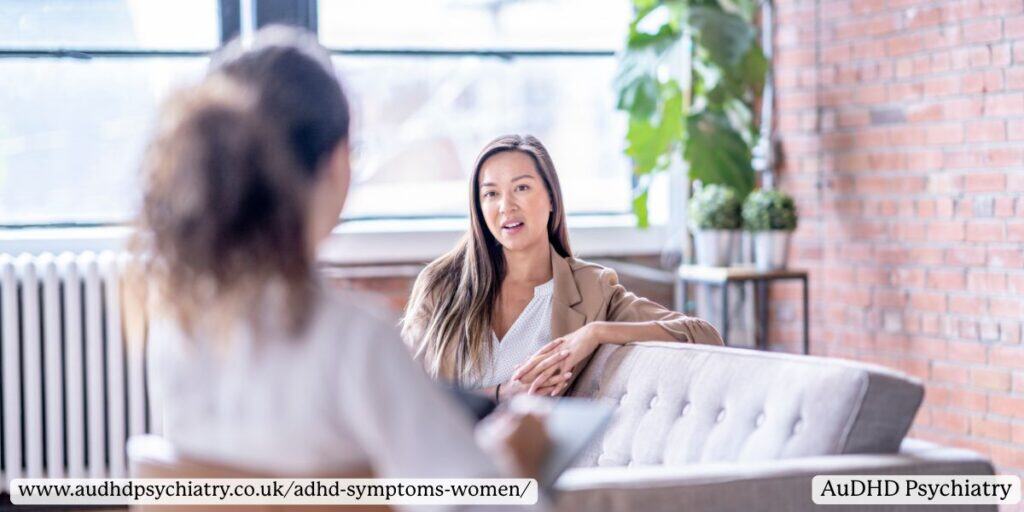
Treatment for ADHD Symptoms in Women
While ADHD can feel overwhelming, effective treatment options exist to help manage symptoms and improve daily functioning. The best approach typically combines ADHD medication, therapy, and structured lifestyle support, tailored to each woman’s individual needs.
Medication and Hormonal Factors
ADHD medications such as stimulants and non-stimulants can be highly effective in improving focus and impulse control. However, hormones can influence how women respond to these treatments. For instance, symptoms may worsen before menstruation, when oestrogen levels fall, potentially affecting medication efficacy.
Women should work closely with their ADHD specialist to find the right treatment plan, adjusting dosage or timing when needed. Open communication about hormonal changes and side effects is essential for achieving balance.
Coaching and Therapy for ADHD
Therapeutic support helps address the emotional and behavioural challenges of female ADHD. Options like cognitive behavioural therapy (CBT), ADHD coaching, or mindfulness-based approaches can help women build structure and self-compassion. Therapy also provides tools to manage low self-esteem, improve communication, and handle impulsive behaviour in relationships or work environments.
Explore our ADHD Medication 101: A Beginner’s Guide to Treatment Options for a full overview of available options and how to discuss them with your clinician.
Lifestyle Support
Practical routines make a major difference in symptom management. Women often benefit from:
- Using digital planners or reminder tools to stay organised
- Incorporating regular exercise and balanced nutrition
- Setting small, realistic goals to prevent overwhelm
- Establishing consistent sleep habits
Resources like ADHD Tools for remembering daily tasks offer actionable strategies for maintaining structure and focus. By combining therapy for ADHD, medication, and daily structure, women can create a sustainable path toward improved focus, energy, and emotional stability.
ADHD in Relationships and Everyday Life
ADHD in women affects more than focus. It shapes emotional and relational well-being. Many struggle with emotional regulation, leading to intense reactions or misunderstandings in relationships. Women with ADHD may appear moody or distracted, but these responses often stem from overwhelm or rejection sensitivity.
Balancing family, work, and social life can feel exhausting, especially when masking symptoms or managing constant mental load. Practical tools like shared calendars, open communication, and supportive routines help ease tension. Building understanding with family members and practising self-awareness strengthens connections and creates a calmer, more fulfilling daily life.
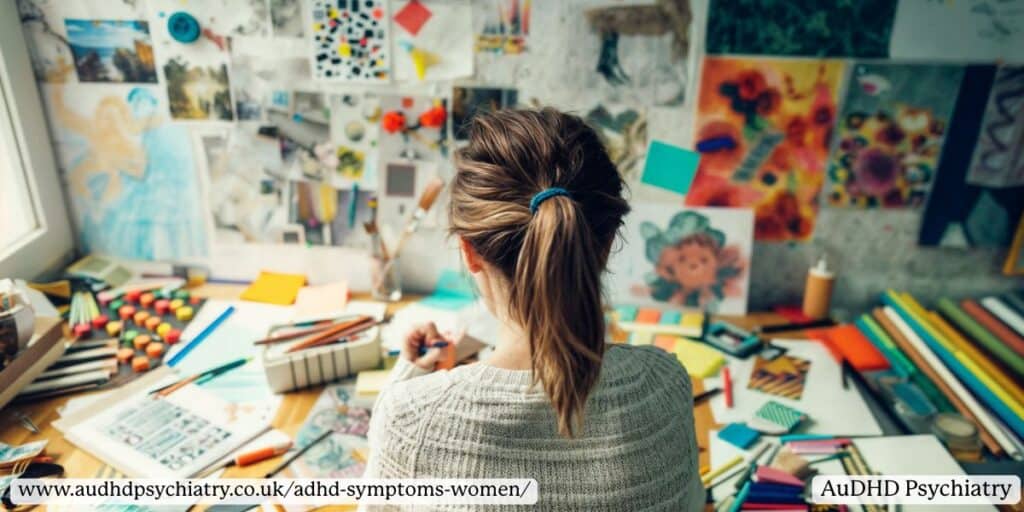
Strengths of Women with ADHD
Although ADHD in women presents challenges, it also comes with remarkable strengths that often go unrecognised. Many women with ADHD display creativity, empathy, and resilience that shape their personal and professional success.
Creativity and Hyperfocus
Periods of hyperfocus—intense concentration on tasks that spark interest—can lead to innovation and exceptional problem-solving. This ability often helps high-functioning ADHD women excel in creative industries or leadership roles where adaptability and insight are valued.
Empathy and Emotional Awareness
Many ADHD women possess deep emotional awareness and empathy. Their sensitivity allows them to connect meaningfully with others and notice subtleties others may overlook—strengths that enrich both relationships and teamwork.
Resilience and Adaptability
Despite obstacles, women with ADHD often show strong resilience, learning to adapt quickly to change and recover from setbacks. These traits highlight that living with ADHD isn’t solely about managing challenges. It’s also about recognising the unique abilities that come with a neurodivergent mind.
Support and Resources for ADHD in Females
Finding the right support can make a lasting difference for ADHD in adult women. Many benefit from connecting with support groups, experienced therapists, or ADHD coaches who understand the female experience.
Who Can Diagnose ADHD in Women?
Working with mental health professionals or clinical psychologists who specialise in ADHD in females can help tailor treatment and lifestyle strategies to each person’s strengths. Emotional validation, structured guidance, and practical tools all play key roles in long-term well-being.
Support doesn’t end after diagnosis. It’s an ongoing process of learning, adapting, and thriving with the right people and resources by your side.
The Need for More Research on Female ADHD
Despite growing awareness, female ADHD remains under-researched compared to male presentations. Historically, most studies have centred on boys, leaving major gaps in understanding how hormonal changes and gender differences influence symptoms.
Recent years have seen progress. New studies published in journals highlight the need for gender-specific diagnostic tools and treatment approaches. These findings show that the prevalence of ADHD in women is likely higher than previously estimated.
More systematic reviews of ADHD in women are vital to close this knowledge gap. Improved data will not only enhance diagnostic accuracy but also promote equality in mental healthcare.
Recognising the full picture of ADHD in women—biologically and socially—ensures future generations receive earlier, more informed support, free from outdated stereotypes.
ADHD Symptoms in Women: Conclusion
ADHD in women often goes unseen, shaped by hormonal changes, social expectations, and years of masking. Recognising the signs of ADHD in adult women, from emotional overwhelm to chronic disorganisation, is the first step toward understanding how these patterns affect daily life. With the right diagnosis, women can access tailored treatment for ADHD, including therapy, medication, and practical lifestyle support that restores focus and self-confidence.
No one should have to navigate these challenges alone. A professional assessment offers clarity, validation, and a clear path forward. If you’ve recognised yourself in the experiences described here, it may be time to take that next step.
Book your private ADHD assessment today through AuDHD Psychiatry and begin building a more balanced, informed, and fulfilling life with expert guidance and care.
References:
- Craddock, E. (2024). Raising the voices of AuDHD women and girls: exploring the co-occurring conditions of autism and ADHD. Disability & Society, 39(8), 2161–2165. https://doi.org/10.1080/09687599.2023.2299342
- Hinshaw, S. P., Nguyen, P. T., O’Grady, S. M., & Rosenthal, E. A. (2021). Annual Research Review: Attention‐deficit/hyperactivity disorder in girls and women: underrepresentation, longitudinal processes, and key directions. Journal of Child Psychology and Psychiatry, 63(4), 484–496. https://doi.org/10.1111/jcpp.13480
You Might Also Like
Contact Us
We’re here to answer any questions you might have.
Get in Touch
Opening Hours
Contact Form
We’re here to help. Reach out and we’ll get back to you within 24 hours (Monday – Friday).


